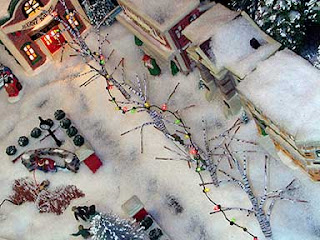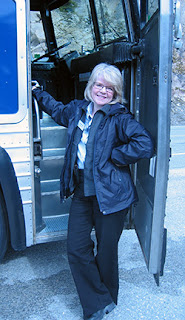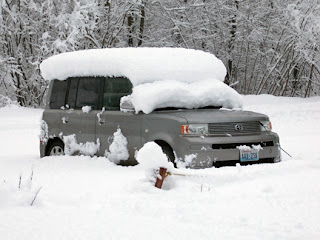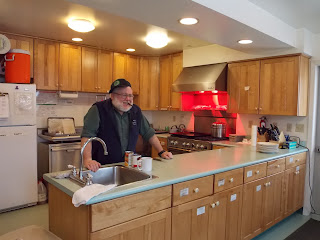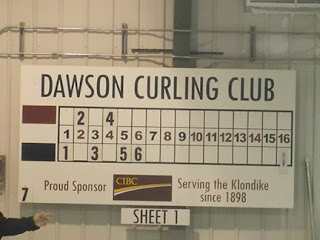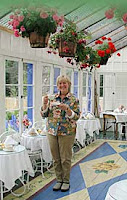_______________________________________________________
IT'S CHRISTMAS 2018, and my normal outlay of decorations are conspicuously absent. No cedar boughs on the patio rail, only a bare-bones light string, a mix-match at that, with no attempt at artistry but embarrassingly tacky. Indoors, I have but one tree, the tiny one. Bubble lights on the mantel, the standard creche. No Bedford Falls village with its street lights and pond where Harry nearly drowned, and icicles hanging off the roof of Bailey Building and Loan. I find it all so understated that the Christmas mood of 2018 evades. Ah, but into the vacuum rushes a thrill far more exciting. I'm going to Skagway three days after Christmas! There is simply no time to take down all my decorations and pack. And I'm sure as heck not going to take it all down in March when I get back. Hence the stripped-down attempt at holiday cheer in favor of the adventure ahead.
"So why do you think Skagway in the winter is a good idea?" friends ask.
 |
| Miss Bea and Be (me) at her summer cabin in Carcros, YK |
Well, coffee with the gang down at the Station. Knitwits every Saturday at Grandma Ginny's for another. Good music from "Jess and J-Dot" and "One-Juan Stand." Miss Bea, of course, the last gold rush baby. If I remember right, the story goes that her father was a gambler in the Gold Rush of 1898. At some point he gambled away the house. Miss Bea's mother left the guy and moved to Juneau. Some years later, Miss Bea's father made good and got either his old house back or made enough to buy a new one. He sent word to Juneau and Miss Bea's mother hopped the ferry and came back. Guess what? Miss Bea was born--circa 1920s--the very last of the gold rush babies.
 |
| Alice's room: the front upstairs room with all the windows |
I'm anxious, too, to see if the ghost who lives (or used to live) in the bedroom above the Skagway Inn's dining room is sound asleep in the great big bed between the floor mirror and bed stand, with a diary from 1898 on top of it. Or whether she truly did "get on with her death" like I suggested she do. She did follow me out of the Inn the summer of 2011, but abandoned me the minute I crossed the street and told her that my boss (yes, I called my boss, not knowing what else to do with her) suggested I invite her to down to the HAP office. Whoosh. She was gone just like that. And in all the summers that followed, I haven't found her. If she's still there, maybe she and I can have a nightcap of Jack Daniels and toast the mysteries of the past.
 |
Lynn Canal, Skagway AK
copyright Jaime Goebel 2018
Owner AK Green Jeeps
and Southeast Tours
Used by permission. |
I want to tromp out to Smuggler's Cove, too, to see if the eagles are out. To see the sun glance of Lynn Canal in the afternoon light. To see if I can find a fox trail.
I want borrow a four-wheel jeep and go out to the once-upon-a-time Dyea Gold Rush town, where 20,000 people prepared for the ridiculously steep Chilkoot Trail and gold beyond, now just one propped up wall of a real estate office. My understanding is that the National Parks Service has cleared a few of the hemlock and Sitka Spruce from the natural forest reclamation of the last 120 years to expose the old grid of streets so one might get a better sense of history. To snowshoe in the shadows is a number one adventure to be had.
 |
| Tim Saulter |
Of course I want to catch Senior Lunch at the "White" church every other day, where Tim Saulter cooks up enough food to take some home. A guy who describes himself as a hairy Pillsbury Doughboy, Tim is a self-confessed admirer. But while I'm highly amused by him and can at times take advantage of his generosity and find his friendship one I'd be loath to lose, I don't share the same ardor. I try to tell him not to take it personally: I find most men unappealing. In 66 years, my heart has gone thumpity-thump but twice--both men finding someone else to marry. "Mitty" takes my apathy with good humor, and lunch at the white church is something I look forward to. It's where all the cool "old" people hang out and the best stories are told.
The real adventure, though, is the dog-mushing. A friend is coming up to visit in January and a whole gaggle of us girls in town are going with her--one more thing on just about everyone's bucket list.
The real adventure, though, is the dog-mushing. A friend is coming up to visit in January and a whole gaggle of us girls in town are going with her--one more thing on just about everyone's bucket list.


